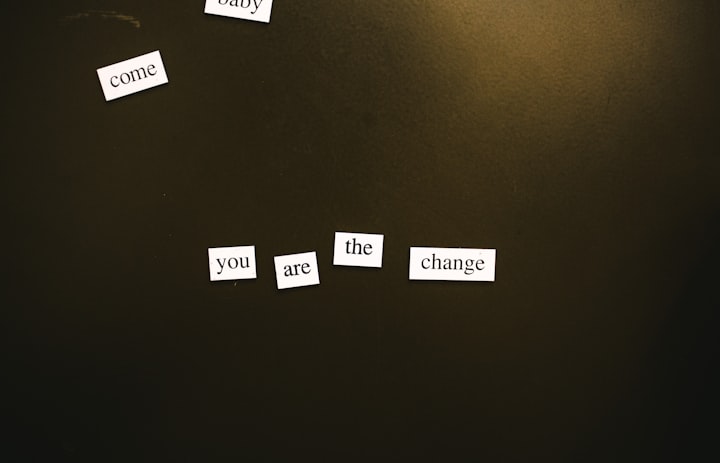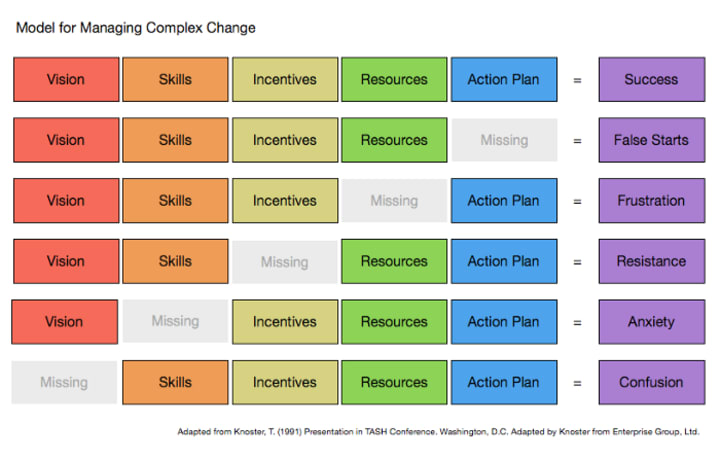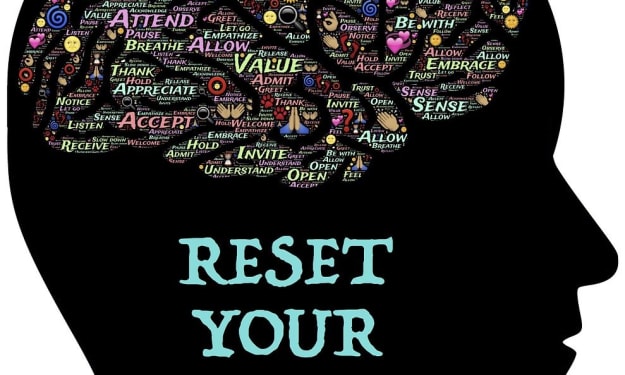You Can Make Change with this Action Plan
Learn to inspire and promote production

A leader is only as strong as the group she directs. She must inspire the organization and organize the people. Thus, the need to be a member of the team is essential. Only as a participant does the leader possess the ability to analyze the direction of movement, determine the skills individuals contribute, define the mission, identify the target and impact change. Therefore, a leader assumes three roles: inspector, scientist, and human relations consultant.
Basic human instinct instills a desire for us to collaborate. Sure, sometimes working alone provides advantages, and I attest, when not required to partnership in a committee, the speed of completion accelerates. I know the assignment is done right, my way. However, I also must admit without others’ input, the final product presents only one perspective, limited insight, and lacks originality. Look to nature for an example of how teamwork improves production.
Geese provide an example of a team that functions in unison to meet their goal. They model the importance of managing resources to attain the highest level of performance. When they fly in V-shape, the flock works together to reduce the drag as the goose in the front breaks the resistance making migration easier for the group. When the leader gets tired, he rotates to the back and a different bird takes his place. The birds all share a common goal and strive to achieve through support of each other.
From this example in nature, comes one very important takeaway, shared leadership expands possibilities.
Whether one person acts as the leader, or the responsibility is shared, the role requires multiple skills to produce successful outcomes and implement change.
The inspector gathers information
By investigating the effective components of the system, the potency of the team is identified. First, an inventory of the stakeholders empowers a leader to evaluate the pulse of the individuals to govern future decisions. Input gathered from employees, clients, support personnel, the community — anybody connected with the institution provides valuable knowledge. If some stakeholders’ interests remain unconsidered, hasty decisions and impulsive actions create anxiety, thereby creating a weak link in the chain resulting in an interruption to the team’s effectiveness.
Second, a statement of resources provides the leader knowledge of how to distribute time, energy, products, and money. Following an accounting of provisions available, needed, beyond reach, as well as, excesses, an inspector increases their ability to proceed in a viable direction. Consider the mechanic attempting to repair a car. He must allow enough time to not only complete the job but leave time for a test drive to assure accuracy for safety. The required tools and parts provide a competent worker a path to success; without a lug wrench and a tire, the car remains crippled. Without needed resources, frustration develops.
The scientist builds long-term success
The scientific method contains five steps: observe, ask a question, form a hypothesis, make a prediction and implementation. A leader applies these five steps in various ways but basically uses the process in much the same manner. With continuous improvement as the goal, a leader examines the environment, analyzes the data and implements best practices to accomplish the vision.
A scientific supervisor uses the process and input from the team to establish a vision. Teach for America’s vision statement reads, “One day, all children in this nation will have the opportunity to attain an excellent education.” Imagine how this process unfolded before arriving at this statement. In the beginning observations, hypotheses and questions generated a dialogue.
- Who are we?
- What is our goal?
- What are we doing?
- What needs to be done?
- What is not being done?
- Are we meeting our potential?
- Who do we hope to impact?
- What outcome is expected?
- How are the terms defined?
With input from stakeholders, the director and team form a prediction; the prediction in business constitutes the vision. Just as a prediction guides the experimentation process for the scientist, the vision defines the purpose, guides the strategy, and communicates the goal. Without a clear vision, confusion impedes progress.
Because science research is generally funded by larger institutions, governments, or grants, they are responsible to establish concrete plans of action. As Antoine de Saint-Exupery believes, “A goal without a plan is just a wish.” Therefore, a leader guides the team to develop a detailed plan of action and is ready to modify or adapt as necessary during implementation. A plan lacking details and uncommunicated fosters false starts with limited forward progress.
“The reason most people never reach their goals is that they don’t define them, or ever seriously consider them as believable or achievable. Winners can tell you where they are going, what they plan to do along the way, and who will be sharing the adventure with them.” ― Denis Waitley, writer and motivational speaker
A human relations consultant fosters collaboration and support for the common vision
The responsibilities of this role require communication and reflection. What one pays attention to gets done. And what one measure gets done well. A leader laboring as a member of the team models a desire to succeed; she provides inspiration and a willingness to influence the outcome, instead of expecting others to toil to accomplish her vision. In this role, the leader provides incentives to encourage and motivate. If all members feel a part of the team, they become invested in producing an internal desire to succeed. When individuals function as active participants with a common goal, the team shares responsibility for the outcome. Resistance occurs without a unified effort from all involved.
Model for Managing Complex Change
A leader who functions as an inspector, scientist, and human relations consultant implements sustainable change. Knoster presented the first version of the Knoster Change Model at a TASH (The Association of Persons with Severe Handicaps) conference in 1991. Since then it has evolved to address varying audiences with the same purpose, to manage change.

The first time I saw this chart, past experiences began to make sense. After reflection, reasons for successes and failures became apparent. When applied to my job as a principal in a public school, I identified areas to improve. As a teacher, strategies to increase students’ success flashed in my mind. Even in my parenting role, I recognized how to be better.
Confusion
When I told my daughter to raise her math grade, I stated my expectation without providing support from change research to help her succeed. I only presented to her my vision. If I really desired change, so much more had to be provided.
False Starts
I noticed she started studying more which created a decrease in missing assignments and an increase in quiz scores, but then she returned to her old pattern of poor study habits. When we developed a plan of action, improvements became sustainable.
Each day after school Sue set aside one hour for homework.
We established a specific time, 3:30–4:30. This fits with our daily routine.
She completed homework at the office desk, downstairs.
The cell phone sat, turned off, in a different room.
Frustration
This plan established a routine but did not end all problems. Sometimes, Sue would forget the assignment, her book or something essential to complete the task, causing both of us frustration. Resources were missing, forgotten, or lost.
- I discovered after a discussion with the teacher a copy of the book was accessible on-line, and she offered to provide one for use at home.
- Sue started carrying a daily planner to record assignments, due dates, and test dates.
- We learned teachers posted expectations on their websites.
- We stocked our office with paper, pencils, a calculator, graph paper — everything needed for class.
Resistance
Nobody wants to work without positive feedback; it goes against human nature. For a teenager, incentives become even more necessary because they have trouble seeing the rewards of long-term goals. We created both internal and external incentives in the study process.
Study time started 30 minutes after arriving home from school, providing some time to unwind and relax.
Thirty minutes into studying, Sue chose one snack.
When Sue earned an appropriate grade on a test or quiz, she chose a weekend opportunity: sleepover, attend a school event, mall shopping, extra phone time, etc.
I made a conscious effort to offer sincere praise for work well done.
Anxiety
We quickly noticed the tension in our home decreased and grades improved. However, a problem persisted. Sue still struggled with math concepts, so we investigated how to build her skills to promote self-efficacy.
- We discovered the school hosts a study club at school once a week during lunch.
- The teacher changed the seating arrangement so that Sue sat beside a study buddy.
- I researched and found several websites that provide guidance; Kahn Academy is exemplary.
- A math tutor started coming to our home once a week.
Once we assembled all the necessary pieces to support our daughter, not only did her grades improve but she gained confidence and our home became a much more pleasant environment.
From my experience, change seldom happens in isolation and doesn’t occur accidentally. Change transpires with effort, thought, planning, and support under the watchful eye and patient hand of a leader. Life presents opportunities to lead, to make a difference, but unless we address these opportunities with the mind of an inspector, scientist, and human relations consultant while implementing the essential elements, change is not sustainable.
“Don’t just exist; do something meaningful with your life. Discover a problem and fix it.
Don’t just fit in; make it a point to brighten your corner. Decide to resolve your challenges.
Don’t just manage; go extra mile and win your race. Never give up the fight. You will win.
Don’t just be able; always make sure you are available. Be present to make a change.
Don’t just be alive; once you have arrived, find the reason why and make that reason accomplished.
Don’t just wish; be passionate about what you wish to see happen. Rise up and make it happen.
Don’t just create; create to change; change to improve; improve to increase. Aspire to inspire.
Don’t just be making a living; make a life and leave an indelible footstep wherever you step.
― Israelmore Ayivor, Become a Better You
About the Creator
Brenda Mahler
Travel
Writing Lessons
Memoirs
Poetry
Books AVAILABLE ON AMAZON.
* Lockers Speak: Voices from America's Youth
* Understanding the Power Not Yet shares Kari’s story following a stroke at 33.
* Live a Satisfying Life By Doing it Doggy Style explains how humans can life to the fullest.






Comments
There are no comments for this story
Be the first to respond and start the conversation.